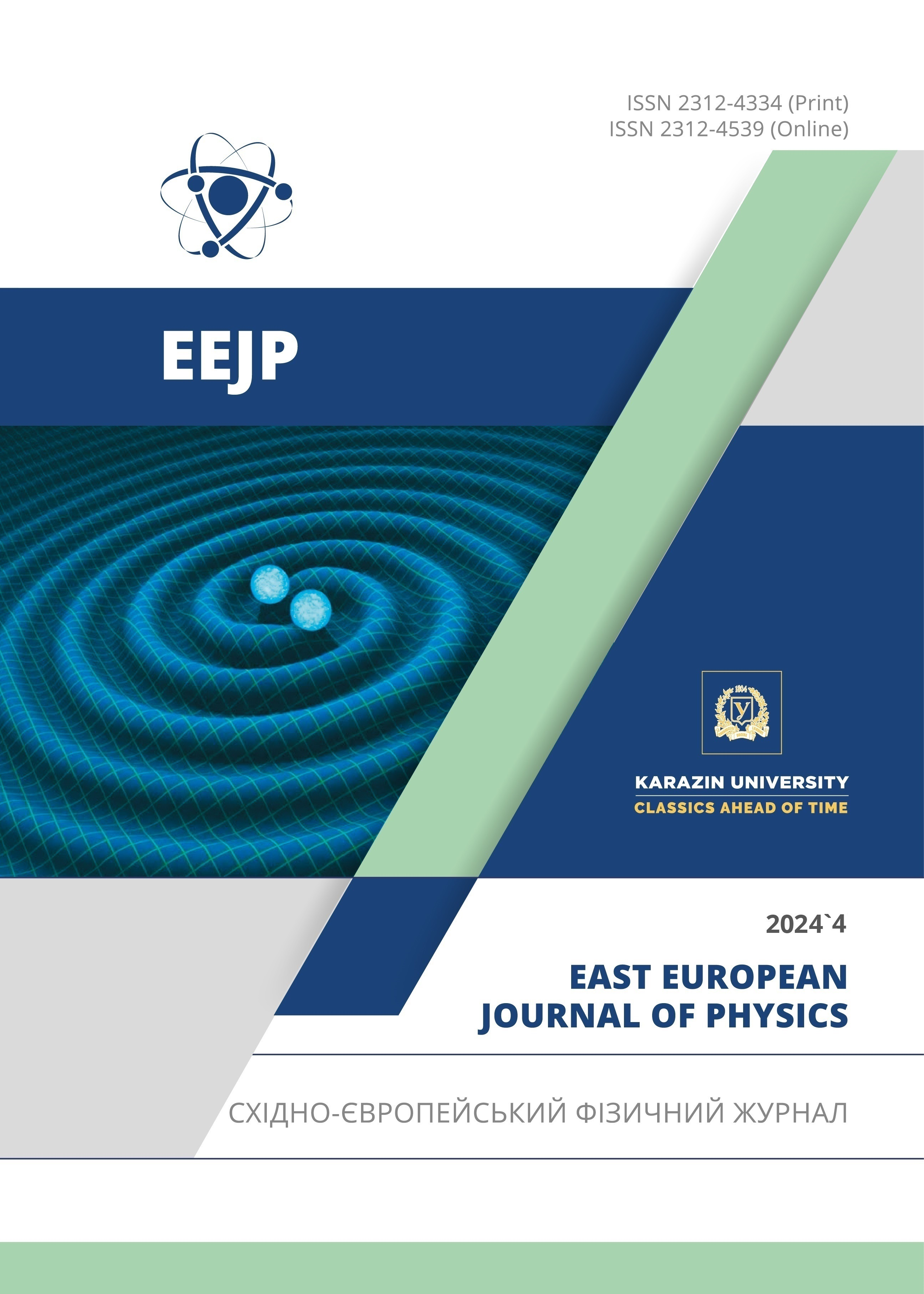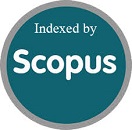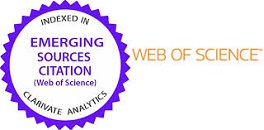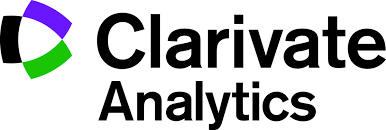A Biomagnetic Couple Stress Fluid Flow in an Anisotropic Porous Channel with Stretching Walls
Abstract
The present study investigates the dynamics of a biomagnetic couple stress fluid within an anisotropic porous channel where the channel walls are stretchable. This study examines the flow behavior under the influence of an external magnetic field generated by a magnetic dipole. Appropriate dimensionless parameters are introduced to simplify the equations of the problem. A suitable numerical approach based on the Spectral Quasi-Linearization Method is utilized to obtain a solution to the problem. In this work, influence of several important parameters like the anisotropic permeability ratio, couple stress parameter, anisotropic angle, Darcy number, ferromagnetic interaction parameter, Reynolds number, and Prandtl number are examined. The results indicate that ferromagnetic interaction parameter and couple stress parameter significantly impact heat transfer and fluid flow. Permeability ratio and angle also affect the flow dynamics. Furthermore, the coefficient of skin friction and rate of heat transfer were examined, varying the couple stress and ferromagnetic interaction parameters. The findings demonstrate that an existence of magnetic dipole and anisotropic permeability significantly influences the flow and thermal properties of ferrofluids, providing valuable insights for optimizing heat transfer and controlling fluid flow in diverse engineering and medical applications.
Downloads
References
L.J. Crane, “Flow past a stretching plate,” Z. Angew. Math. Phys. 21, 645-647 (1970). https://doi.org/10.1007/BF01587695
R.E. Rosensweig, Ferrohydrodynamics, (Cambridge University Press. Cambridge, (1985).
S. Odenbach, Magnetoviscous Effects in Ferrofluids, (Springer, Berlin, 2002).
N.H. Abu-Hamdeh, R.A.R. Bantan, F. Aalizadeh, and A. Alimoradi, “Controlled drug delivery using the magnetic nanoparticles in non-Newtonian blood vessels,” Alexandria Engineering Journal, 59, 4819–4828 (2020). https://doi.org/10.1016/j.aej.2020.07.010
M. Kole, and S. Khandekar, “Engineering applications of ferrofluids: A review,” Journal of Magnetism and Magnetic Materials, 537, 168222 (2021). https://doi.org/10.1016/j.jmmm.2021.168222
M.S. Pattanaik, V.B. Varma, S.K. Cheekati, V. Chaudhary, and R.V. Ramanujan, “Optimal ferrofluids for magnetic cooling devices,” Scientific Reports, 11(1), (2021). https://doi.org/10.1038/s41598-021-03514-2
N. Kastor, B. Dandu, V. Bassari, G. Reardon, and Y. Visell, “Ferrofluid electromagnetic actuators for high-fidelity haptic feedback,” Sensors and Actuators a Physical, 355, 114252 (2023). https://doi.org/10.1016/j.sna.2023.114252
E.E. Tzirtzilakis, “A mathematical model for blood flow in magnetic field,” Physics of Fluids, 17(7), (2005). https://doi.org/10.1063/1.1978807
J.C. Misra, G.C. Shit, and H.J. Rath, “Flow and heat transfer of a MHD viscoelastic fluid in a channel with stretching walls: Some applications to haemodynamics,” Computers and Fluids, 37(1), 1–11 (2008). https://doi.org/10.1016/j.compfluid.2006.09.005
Misra, J.C., and Shit, G.C., “Flow of a biomagnetic visco-elastic fluid in a channel with stretching walls,” J. Appl. Mech. 76(6), 061006 (2009). https://doi.org/10.1115/1.3130448.
J.C. Misra, B. Pal, and A.S. Gupta, “Hydromagnetic flow of a second-grade fluid in a channel—Some applications to physiological systems,” Math. Models Meth. Appl. Sci. 8, 1323-1342 (1998). https://doi.org/10.1142/S0218202598000627
V.K. Stokes, “Couple stress in fluids,” Phys. Fluids, 9, 1709-1715 (1966). https://doi.org/10.1063/1.1761925
K. Abbas, X. Wang, G. Rasool, T. Sun, G. Yin, and I. Razzaq, “Recent developments in the application of ferrofluids with an emphasis on thermal performance and energy harvesting,” J. Magn. Magn. Mater. 587, 171311 (2023). https://doi.org/10.1016/j.jmmm.2023.171311
R.K. Shah and S. Khandekar, “Exploring ferrofluids for heat transfer augmentation,” J. Magn. Magn. Mater. 475, 389-400 (2019). https://doi.org/10.1016/j.jmmm.2018.11.034
M. Nandeppanavar, K. Vajravelu, M. Abel, and M.N. Siddalingappa, “Second order slip flow and heat transfer over a stretching sheet with non-linear Navier boundary condition,” Int. J. Therm. Sci. 58, 143-150 (2012). https://doi.org/https://doi.org/10.1016/j.ijthermalsci.2012.02.019
K. Ramesh, “Influence of heat and mass transfer on peristaltic flow of a couple stress fluid through porous medium in the presence of inclined magnetic field in an inclined asymmetric channel,” J. Mol. Liq. 219, 256-271 (2016). https://doi.org/10.1016/j.molliq.2016.03.010
M. Reddy and R.M. Josyula, “Effect of magnetic field on couple stress fluid flow in a rectangular channel,” AIP Conf. Proc. 2246, 020057 (2020). https://doi.org/10.1063/5.0014635
R. Mahesh, A.B. Vishalakshi, U. Mahabaleshwar, and F. Sofos, “Impact of an inclined magnetic field on couple stress fluid flow over a stretching surface with effect of Stefan blowing, radiation and chemical reaction,” J. Magn. Magn. Mater. 580, 170953 (2023). https://doi.org/10.1016/j.jmmm.2023.170953
M. Naveed, M. Imran, and S. Gul, “Heat transfer analysis in hydromagnetic flow of couple stress fluid in presence of homogeneous and heterogeneous chemical reactions over a porous oscillatory stretchable sheet,” Adv. Mech. Eng. 15(2), 16878132231155823 (2023). https://doi.org/10.1177/16878132231155823
H.I. Andersson, K.H. Bech, and B.S. Dandapat, “Magnetohydrodynamic flow of a power-law fluid over a stretching sheet,” Int. J. Non-Linear Mech. 27, 929-936 (1992). https://doi.org/10.1016/0020-7462(92)90045-9
M.A.A. Mahmoud and M.A.E. Mahmoud, “Analytical solutions of hydromagnetic boundary layer flow of a non-Newtonian power-law fluid past a continuously moving surface,” Acta Mech. 181, 83-89 (2006). https://doi.org/10.1007/s00707-005-0268-5
M.Yang, and Y. Lin, “Flow and heat transfer of non-Newtonian power-law fluids over a stretching surface with variable thermal conductivity,” Multidiscip. Model. Mater. Struct. 15(4), 678-695 (2019). https://doi.org/10.1108/MMMS-08-2018-0147
S. Nadeem, R.U. Haq, and C. Lee, “MHD flow of a Casson fluid over an exponentially shrinking sheet,” Scientia Iranica, 19(6), 1550–1553 (2012). https://doi.org/10.1016/j.scient.2012.10.021
P.K. Yadav and N. Yadav, “A study on the flow of couple stress fluid in a porous curved channel,” Comput. Math. Appl. 152, 1-15 (2023). https://doi.org/10.1016/j.camwa.2023.10.004
M. Ishaq, S.U. Rehman, M.B. Riaz, and M. Zahid, “Hydrodynamical study of couple stress fluid flow in a linearly permeable rectangular channel subject to Darcy porous medium and no-slip boundary conditions,” Alexandria Engineering Journal, 91, 50–69 (2024). https://doi.org/10.1016/j.aej.2024.01.066
S. Das, R.R. Patra, and R.N. Jana, “The layout of Boussinesq couple-stress fluid flow over an exponentially stretching sheet with slip in porous space subject to a variable magnetic field,” Multidiscipline Modeling in Materials and Structures, 16(5), 1131–1154 (2020). https://doi.org/10.1108/MMMS-09-2019-0168
R.A. Alharbey, H. Mondal, and R. Behl, “Spectral Quasi-Linearization Method for Non-Darcy Porous Medium with Convective Boundary Condition,” Entropy, 21(9), 838 (2019). https://doi.org/10.3390/e21090838
H. Mondal and S. Bharti, “Spectral Quasi-linearization for MHD Nanofluid Stagnation Boundary Layer Flow due to a Stretching/Shrinking Surface,” J. Appl. Comput. Mech. 6(4), 1058-1068 (2020). https://doi.org/10.22055/jacm.2020.33097.2207
D. Srinivasacharya, and K.H. Bindu, “Entropy generation in a micropolar fluid flow through an inclined channel with slip and convective boundary conditions,” Energy, 91, 72–83 (2015). https://doi.org/10.1016/j.energy.2015.08.014
K. Raj, B. Moskowitz, and R. Casciari, “Advances in ferrofluid technology,” Journal of Magnetism and Magnetic Materials, 149(1–2), 174–180 (1995). https://doi.org/10.1016/0304-8853(95)00365-7
T. Karmakar, M. Reza, and G.P.R. Sekhar, “Forced convection in a fluid saturated anisotropic porous channel with isoflux boundaries,” Physics of Fluids, 31(11), (2019). https://doi.org/10.1063/1.5126892
T. Karmakar, M. Alam, M. Reza, and G.P.R. Sekhar, “Couette-Poiseuille flow in a fluid overlying an anisotropic porous layer,” Comput. Math. Appl. 151, 346-358 (2023). https://doi.org/10.1016/j.camwa.2023.10.006
N. Ghosh, T. Karmakar, and G.P. Raja Sekhar, “Application of conformal mapping to two-dimensional flows in an anisotropic aquifer,” Indian J. Pure Appl. Math. 53, 617–626 (2022). https://doi.org/10.1007/s13226-021-00153-1
T. Karmakar, and G.P. Raja Sekhar, “A note on flow reversal in a wavy channel filled with anisotropic porous material,” Proc. R. Soc. A, 473, 20170193 (2017). https://doi.org/10.1098/rspa.2017.0193
T. Karmakar, and G. P. Raja Sekhar, “Squeeze-film flow between a flat impermeable bearing and an anisotropic porous bed,” Phys. Fluids, 30, 042001 (2018). https://doi.org/10.1063/1.5020135
T. Karmakar, and G.P. Raja Sekhar, “Effect of anisotropic permeability on fluid flow through composite porous channel,” J. Eng. Math. 100, 33-51 (2016). https://doi.org/10.1007/s10665-015-9831-9
S. Pramanik, and T. Karmakar, “Couette–Poiseuille flow of variable viscosity in a multilayered channel partially filled with a homogeneous anisotropic porous layer: Role of the glycocalyx in attenuating shear stress on endothelial cells,” Physics of Fluids, 36(3), (2024). https://doi.org/10.1063/5.0188683
D.A.S. Rees, L. Storesletten, and A. Postelnicu, “The onset of convection in an inclined anisotropic porous layer with oblique principal axes,” Transp. Porous Media, 62, 139–156 (2006). https://doi.org/10.1007/s11242-005-0618-8
M. Norouzi, and M.R. Shoghi, “A numerical study on miscible viscous fingering instability in anisotropic porous media,” Phys. Fluids, 26, 084102 (2014). https://doi.org/10.1063/1.4891228
E.E. Tzirtzilakis, N.G. Kafoussias, and P.M. Hatzikonstantinou, “Biomagnetic fluid flow in a 3D rectangular duct,” Int. J. Numer. Methods Fluids, 44(12), 1279-1298 (2004). https://doi.org/10.1002/fld.618
Copyright (c) 2024 R. Vijaya Sree, V. K. Narla, K. Suresh Babu

This work is licensed under a Creative Commons Attribution 4.0 International License.
Authors who publish with this journal agree to the following terms:
- Authors retain copyright and grant the journal right of first publication with the work simultaneously licensed under a Creative Commons Attribution License that allows others to share the work with an acknowledgment of the work's authorship and initial publication in this journal.
- Authors are able to enter into separate, additional contractual arrangements for the non-exclusive distribution of the journal's published version of the work (e.g., post it to an institutional repository or publish it in a book), with an acknowledgment of its initial publication in this journal.
- Authors are permitted and encouraged to post their work online (e.g., in institutional repositories or on their website) prior to and during the submission process, as it can lead to productive exchanges, as well as earlier and greater citation of published work (See The Effect of Open Access).








